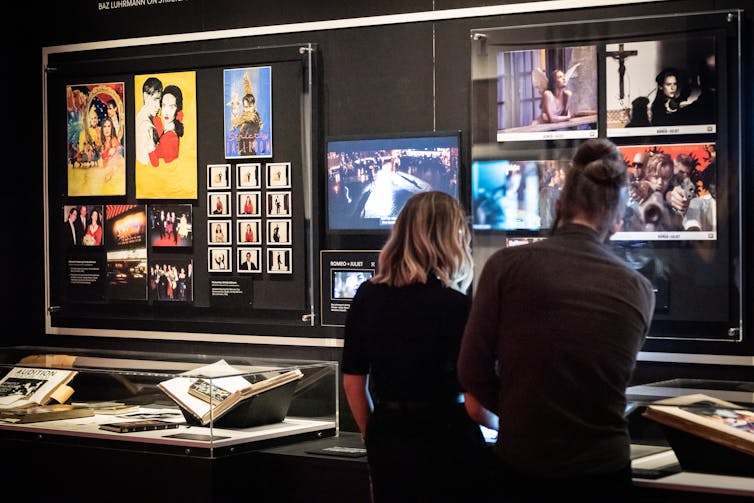
Review: Australians & Hollywood, National Film and Sound Archive
Visitors are greeted in the foyer of the National Film and Sound Archive (NFSA) by a life-size wax figure of the actor Eric Bana, on loan from Madame Tussaud’s, poised and ready for selfies.
Three ferocious steering wheels from Mad Max: Fury Road are provided by George Miller. Exquisite can-can costumes from Moulin Rouge are part of the Bazmark (the production company led by Baz Luhrmann and Catherine Martin) memorabilia housed by the NFSA.
Australians & Hollywood, the new exhibition at the archive, brings together objects from inside and outside the collections. The focus on Australia’s relationship with Hollywood is rich and timely. Curator Tara Marynowsky foregrounds the transnational dimensions of Australia’s film industry, drawing on the idea of Hollywood as a dispersed global phenomenon.
The subtitle of the exhibition, “a tale of craft, talent and ambition”, is an apt characterisation of her approach. The three concepts come to the fore in various locations and experiences throughout the space.
Craft
One of the most pleasurable aspects of the exhibition is its focus on craft.
Not surprisingly, this is prominent in the section titled “George Miller and His Universe”.
Miller rose to international prominence as the director of the Mad Max film franchise, and the exhibition highlights the eclectic scavenging undertaken by costume designer Norma Moriceau for her work on Mad Max 2 (1981) and Mad Max Beyond Thunderdome (1985).

The juxtaposition of this work with her design of Paul Hogan’s vest, hat and knife from Crocodile Dundee (1986) is a reminder of her influence over some of Australia’s most iconic and enduring cinematic imagery.
A variety of digitally rendered concept books and storyboards are dispersed throughout the exhibition space. The storyboards for Mad Max and Crocodile Dundee are joined by several stunning concept books put together under Catherine Martin’s design leadership for Bazmark productions, for films like Romeo + Juliet (1996) and Moulin Rouge (2001).
Through these early design works, we get the opportunity to explore a variety of approaches different creative teams bring to this process, from scruffy hand-drawn sketches to extensive collages envisioning individual shots as well as whole cinematic universes.
Read more: Baz Luhrmann's Romeo + Juliet at 25: is this the best Shakespeare screen adaptation?
Ambition
I found the emphasis on the concept of ambition quite intriguing, particularly in terms of how this notion manifests in the section on the production company Blue-Tongue Films and their 2010 hit Animal Kingdom.
Animal Kingdom helped launch the Hollywood careers of filmmaker David Michôd and actors Ben Mendelsohn and Jacki Weaver.

A quote on the wall from Mendelsohn declares that, if he had been able to tell his younger self he woudld one day be in a Star Wars movie, he could have saved himself a lot of angst. In an audio interview, we hear of his undignified couch surfing days in Los Angeles.
An interview with Nicole Kidman in another corner of the exhibition dwells on similar stories about her early days slumming it in LA, surviving on the generosity of fellow Aussies.
Ambition, as this exhibition tells it, is frequently associated with resilience, grit and mateship.
Talent
While the Blue-Tongue and Bazmark sections emphasise collaboration, the focus of the exhibition is primarily on individuals, cleverly utilised as a tool through which facets of the industry are brought to the fore.
The emphasis on celebrating Australian talent and success is brought to life most explicitly in relation to the Academy Awards.

Producer Emile Sherman’s Oscar for best film, awarded to The King’s Speech (2010) is there, encased in glass. And there are numerous curated clips of interviews and thank you speeches from Australian actors and filmmakers in red carpet attire clutching trophies.
We’re left in no doubt about the recognition Hollywood has given Australian talent since the 1970s. Photographs peppered throughout the exhibition showcase the Hollywood careers of filmmakers like Miller, Phillip Noyce, Peter Weir, Sherman and Cate Shortland as well as actors like Cate Blanchett, Kidman, Bana and Weaver.
The missing stories
It is certainly a challenge to attempt to tackle the variety and complexity of the Australian industry’s relations with Hollywood, especially within this small, single exhibition space. And there is no doubt that this exhibition packs in an engaging variety of interesting objects and resources.
But while it looks at Australian talent being exported to Hollywood, it attends more briefly to the phenomenon of Hollywood productions on Australian soil.

There is some on-set photography from some of these productions including a number of Miller and Bazmark films as well as Thor: Ragnarok (2017), but there is little focus on the production studios and post-production facilities and teams that have contributed to these kinds of films over the decades.
Similarly, the exhibition showcases the success of Australia’s First Nations practitioners like Warwick Thornton and Rachel Perkins, but only briefly references the weaving of Indigenous culture into the Hollywood blockbuster Thor: Ragnarok.
Certainly, there is much to enjoy. We get multiple opportunities to peer behind-the-scenes, whether it’s getting up close and personal with iconic costumes and props or listening to actors reflect on their artistic and personal journeys. It is a delightful and engaging representation of our rich and diverse audiovisual heritage.
Australians & Hollywood is at the National Film and Sound Archive, Canberra, until July 17.
Megan Carrigy does not work for, consult, own shares in or receive funding from any company or organisation that would benefit from this article, and has disclosed no relevant affiliations beyond their academic appointment.
This article was originally published on The Conversation. Read the original article.







